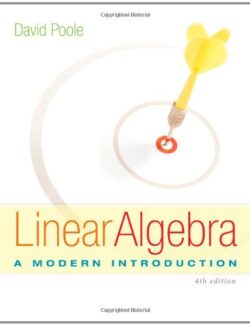

David Poole’s innovative LINEAR ALGEBRA: A MODERN INTRODUCTION, 4e emphasizes a vectors approach and better prepares students to make the transition from computational to theoretical mathematics. Balancing theory and applications, the book is written in a conversational style and combines a traditional presentation with a focus on student-centered learning.
Theoretical, computational, and applied topics are presented in a flexible yet integrated way. Stressing geometric understanding before computational techniques, vectors and vector geometry are introduced early to help students visualize concepts and develop mathematical maturity for abstract thinking. Additionally, the book includes ample applications drawn from a variety of disciplines, which reinforce the fact that linear algebra is a valuable tool for modeling real-life problems. Have tried to limit the number of theorems in the text. For the most part, results labeled as theorems either will be used later in the text or summarize preceding work. Interesting results that are not central to the book have been included as exercises or explorations.
1 Vectors
1.1 The Geometry and Algebra of Vectors
1.2 Length and Angle: The Dot Product
Exploration: Vectors and Geometry
1.3 Lines and Planes
Exploration: The Cross Product
1.4 Applications
Chapter Review
2 Systems of Linear Equations
2.1 Introduction to Systems of Linear Equations
2.2 Direct Methods for Solving Linear Systems
Exploration: Lies My Computer Told Me
Exploration: Partial Pivoting
Exploration: An Introduction to the Analysis of Algorithms
2.3 Spanning Sets and Linear Independence
2.4 Applications
2.5 Iterative Methods for Solving Linear Systems
Chapter Review
3 Matrices
3.1 Matrix Operations
3.2 Matrix Algebra
3.3 The Inverse of a Matrix
3.4 The LU Factorization
3.5 Subspaces, Basis, Dimension, and Rank
3.6 Introduction to Linear Transformations
3.7 Applications
Chapter Review
4 Eigenvalues and Eigenvectors
4.1 Introduction to Eigenvalues and Eigenvectors
4.2 Determinants
Exploration: Geometric Applications of Determinants
4.3 Eigenvalues and Eigenvectors of n × n Matrices
4.4 Similarity and Diagonalization
4.5 Iterative Methods for Computing Eigenvalues
4.6 Applications and the Perron-Frobenius Theorem
Chapter Review
5 Orthogonality
5.1 Orthogonality in Rn
5.2 Orthogonal Complements and Orthogonal Projections
5.3 The Gram-Schmidt Process and the QR Factorization
Exploration: The Modified QR Process
Exploration: Approximating Eigenvalues with the QR Algorithm
5.4 Orthogonal Diagonalization of Symmetric Matrices
5.5 Applications
Chapter Review
6 Vector Spaces
6.1 Vector Spaces and Subspaces
6.2 Linear Independence, Basis, and Dimension
Exploration: Magic Squares
6.3 Change of Basis
6.4 Linear Transformations
6.5 The Kernel and Range of a Linear Transformation
6.6 The Matrix of a Linear Transformation
Exploration: Tiles, Lattices, and the Crystallographic Restriction
6.7 Applications
Chapter Review
7 Distance and Approximation
7.1 Inner Product Spaces
Exploration: Vectors and Matrices with Complex Entries
Exploration: Geometric Inequalities and Optimization Problems
7.2 Norms and Distance Functions
7.3 Least Squares Approximation
7.4 The Singular Value Decomposition
7.5 Applications
Chapter Review
8 Codes
8.1 Code Vectors
8.2 Error-Correcting Codes
8.3 Dual Codes
8.4 Linear Codes
8.5 The Minimum Distance of a Code